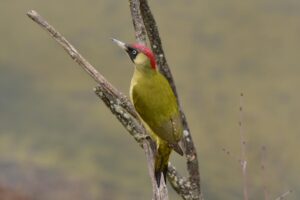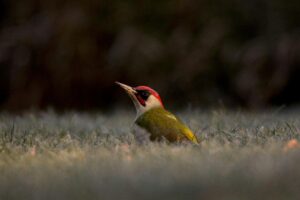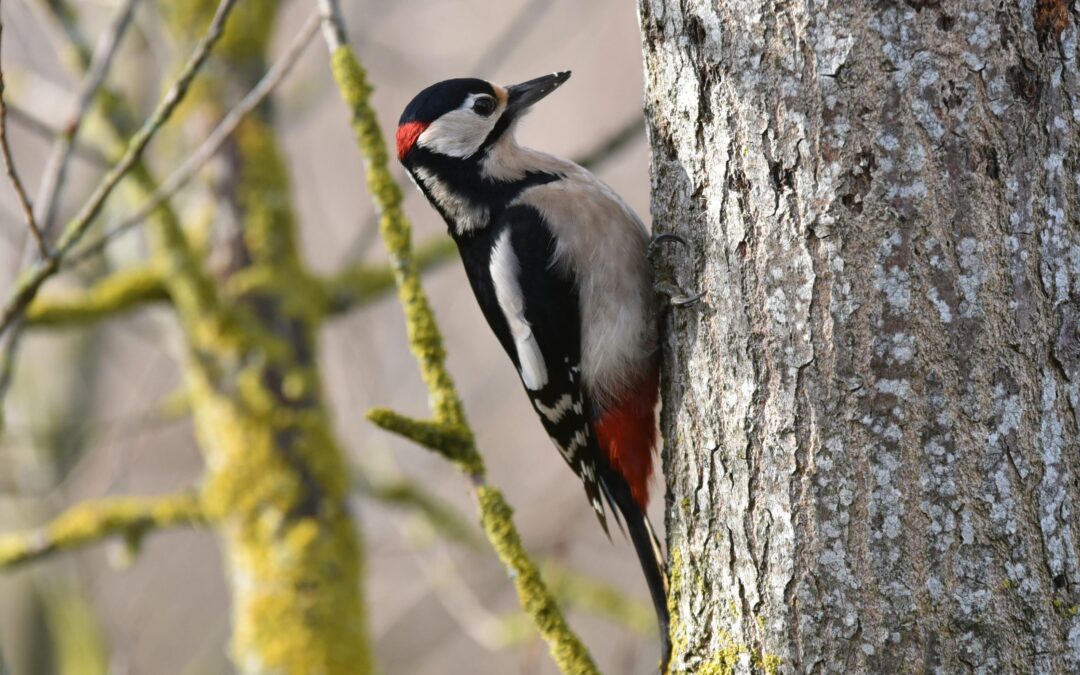Introduction to the Fascinating World of Woodpeckers
Woodpeckers belong to the family Picidae, which includes around 240 species worldwide. They are found on every continent except Australia and Antarctica, thriving in a variety of environments from dense forests to suburban areas. These birds are easily recognizable by their strong, pointed beaks and the repetitive drumming sounds they produce when pecking at wood. But what makes woodpeckers truly fascinating is their unique adaptations that allow them to thrive in their specialized niches.
The Anatomy of Woodpeckers
One of the most remarkable features of woodpeckers is their ability to drill into trees without injuring themselves. Several unique physical adaptations make this possible:
Reinforced Skulls
Woodpeckers have thick skulls and a specialized bone structure that helps absorb the impact of pecking.
Strong Necks
Their neck muscles are exceptionally strong, providing the necessary force and control for pecking.
Chisel-like Beaks
Their beaks are designed to chisel through wood efficiently.
Shock-Absorbing Tissue
Between their beak and skull, woodpeckers have a layer of spongy tissue that acts as a shock absorber.
Zygodactyl Feet
With two toes facing forward and two backward, their feet provide a strong grip on tree trunks.
Types of Woodpeckers
The following are some types of woodpeckers:
Great Spotted Woodpecker
The great spotted woodpecker (Dendrocopos major) is one of the most recognizable and widespread woodpecker species across Europe and parts of Asia. Known for its striking plumage, this bird features contrasting black and white feathers with a distinctive red patch on the lower belly and, in males, a red nape. Juveniles also have a red cap.

Green Woodpecker
The green woodpecker (Picus viridis) is a striking and distinctive bird found across much of Europe and parts of Western Asia. Easily recognizable by its vibrant green plumage, yellowish undertail, and bright red crown, the green woodpecker is a favourite among bird watchers due to its colourful appearance and unique behaviour. Notably, this species has a laughing call often described as a “yaffle,” which can be heard echoing through woodlands and open spaces.

European Green Woodpecker
The European Green Woodpecker (Picus viridis viridis) is a subspecies of the green woodpecker, distinguished by its vibrant green body, yellowish underparts, and a distinct red crest. Found predominantly in Europe, this bird thrives across a range of environments including deciduous forests, farmlands, and even urban parks with suitable nesting trees. The European Green Woodpecker shares many behavioural and dietary characteristics with its broader species, favouring ants as its primary food source and foraging largely on the ground.

Woodpecker Habitats and Nests
Woodpeckers are incredibly versatile when it comes to choosing their habitats. They can be found in coniferous, deciduous, and mixed forests, as well as in suburban and urban areas with sufficient tree cover. When it comes to nesting, woodpeckers are cavity nesters. They excavate holes in tree trunks or branches to create their nests, which provide protection against predators and harsh weather conditions.
Types of Woodpecker Nests
Primary Cavity Nesters
These woodpeckers, such as the great spotted woodpecker, excavate their own nest cavities.
Secondary Cavity Nesters
Some woodpeckers, like the northern flicker, may use abandoned cavities created by other birds or animals.
Woodpeckers’ Diet and Feeding Behavior
Woodpeckers have a diverse diet that varies depending on the species and the season. Their primary food sources include insects, fruits, nuts, and sap.
Feeding Techniques
Drilling and Excavation
Woodpeckers use their beaks to drill into wood to find insects and larvae.
Probing
They use their long, sticky tongues to extract insects from crevices.
Gleaning
Some species pick insects off the surface of trees or the ground.
Sapping
Certain species, like the yellow-bellied sapsucker, drill rows of holes in trees to feed on the sap.
Their varied diet and feeding behavior make woodpeckers essential for controlling insect populations and promoting forest health.
Woodpeckers’ Role in Ecosystems
Woodpeckers play a crucial role in maintaining the balance of ecosystems. By excavating tree cavities, they create habitats for other species, including birds, mammals, and insects. Additionally, their feeding habits help control insect populations, reducing the risk of pest infestations that can harm trees.
Ecological Contributions
Habitat Creation
The cavities woodpeckers create are used by many secondary cavity nesters, contributing to biodiversity.
Pest Control
By feeding on insects, woodpeckers help keep pest populations in check, promoting forest health.
Seed Dispersal
Some woodpecker species, like the acorn woodpecker, play a role in dispersing seeds, aiding in plant regeneration.
Threats to Woodpecker Populations
Despite their ecological importance, woodpeckers face several threats that jeopardize their populations. Habitat loss due to deforestation, urbanization, and climate change are among the most significant challenges. Additionally, woodpeckers are sometimes persecuted by humans for damaging trees or wooden structures.
Key Threats
Habitat Loss
The destruction of forests and woodlands reduces the availability of suitable nesting and foraging sites.
Climate Change
Changes in climate can alter the distribution of woodpecker populations and the availability of their food sources.
Human Conflict
Woodpeckers sometimes peck on wooden structures, leading to conflicts with humans who may see them as pests.
Conservation Efforts and How You Can Help
Conservation efforts are crucial for ensuring the survival of woodpecker populations. Various organizations work to protect and restore woodpecker habitats, conduct research, and raise awareness about the importance of these birds.
How You Can Help
Support Conservation Organizations
Contribute to organizations dedicated to protecting woodpecker habitats and conducting research.
Create Habitat
If you have a garden or property, consider leaving dead trees or installing nesting boxes to provide potential nesting sites.
Reduce Pesticide Use
Limiting pesticide use can help maintain healthy insect populations for woodpeckers to feed on.
Spread Awareness
Educate others about the importance of woodpeckers and the challenges they face.
Conclusion
Woodpeckers are more than just fascinating birds; they are vital components of healthy ecosystems. From their unique anatomical features to their critical roles in pest control and habitat creation, woodpeckers deserve our admiration and protection. By understanding the challenges they face and supporting conservation efforts, we can ensure that these incredible birds continue to thrive in our forests and beyond.
Let’s work together to appreciate and protect the remarkable world of woodpeckers. If you’re interested in learning more about wildlife and how you can make a difference, subscribe to our newsletter and join our community of nature enthusiasts.
FAQs
Woodpecker Cider is a popular brand of English cider known for its light, fruity taste and lower alcohol content.
There are over 200 species of woodpeckers distributed across the world, with the exception of Australia, Madagascar, and Antarctica.
Woodpecker Cider is produced in Hereford, England, utilizing local apples for a crisp and refreshing flavor.

